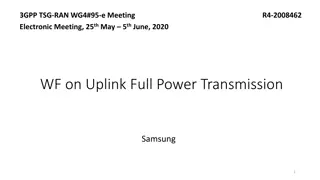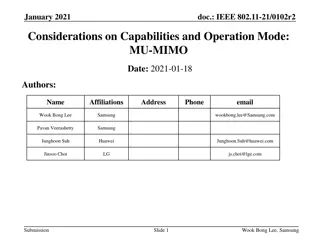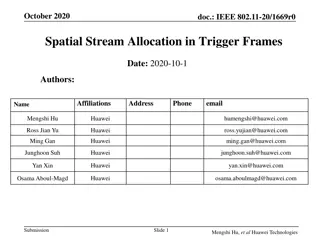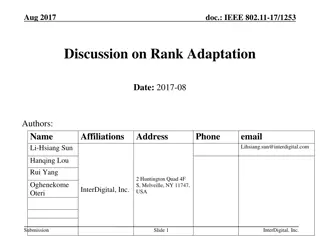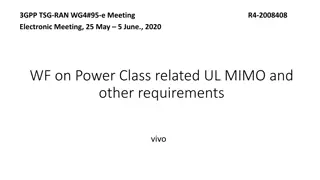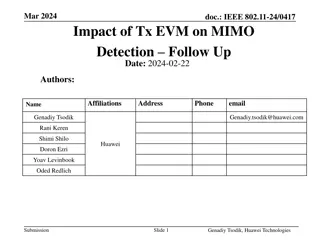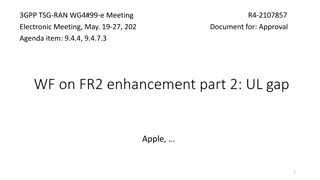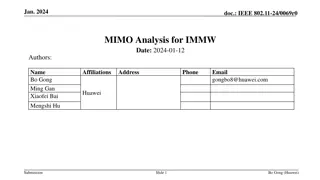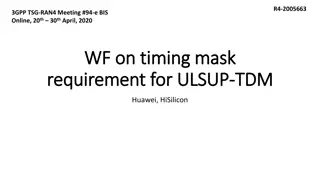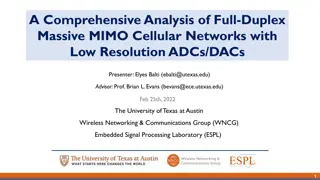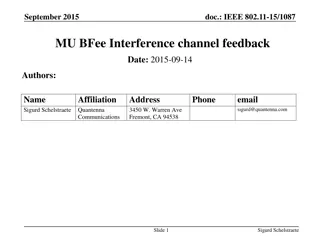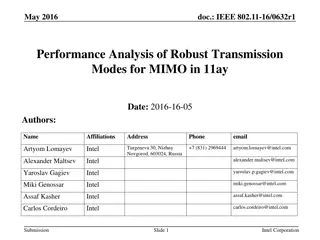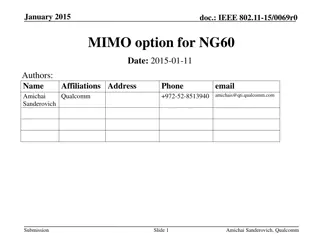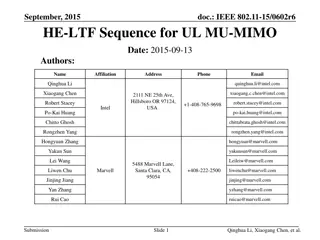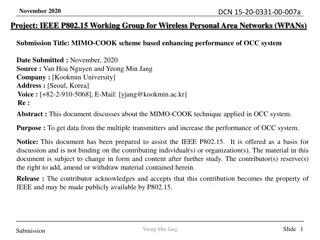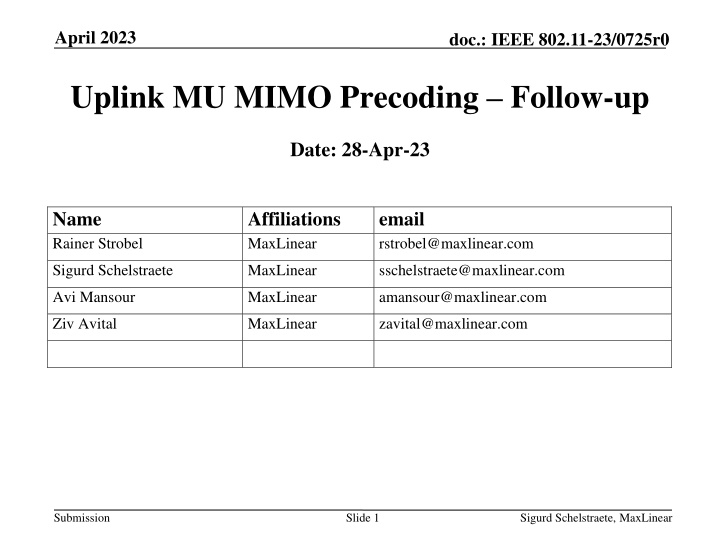
Advanced Uplink MU-MIMO Precoding Techniques in IEEE 802.11 for Improved Performance
Explore the latest advancements in uplink MU-MIMO precoding presented in the April 2023 IEEE 802.11 document. Discover how these techniques enhance uplink rate and reliability through detailed simulations and performance comparisons. Learn about MAC overhead, channel aging effects, nonlinear receivers, and precoder calculations for optimal results.
Download Presentation

Please find below an Image/Link to download the presentation.
The content on the website is provided AS IS for your information and personal use only. It may not be sold, licensed, or shared on other websites without obtaining consent from the author. If you encounter any issues during the download, it is possible that the publisher has removed the file from their server.
You are allowed to download the files provided on this website for personal or commercial use, subject to the condition that they are used lawfully. All files are the property of their respective owners.
The content on the website is provided AS IS for your information and personal use only. It may not be sold, licensed, or shared on other websites without obtaining consent from the author.
E N D
Presentation Transcript
April 2023 doc.: IEEE 802.11-23/0725r0 Uplink MU MIMO Precoding Follow-up Date: 28-Apr-23 Name Rainer Strobel Affiliations MaxLinear email rstrobel@maxlinear.com Sigurd Schelstraete MaxLinear sschelstraete@maxlinear.com Avi Mansour MaxLinear amansour@maxlinear.com Ziv Avital MaxLinear zavital@maxlinear.com Submission Slide 1 Sigurd Schelstraete, MaxLinear
April 2023 doc.: IEEE 802.11-23/0725r0 Introduction [1] presented uplink MU MIMO precoding for uplink rate and reliability improvement This contribution gives more simulation results and details to respond to the questions raised for [1]: MAC overhead and channel aging Additional simulations Comparison to beamforming Performance on LOS channels Performance with 3 stations Nonlinear Receiver Details on the precoder calculation Submission Slide 2 Sigurd Schelstraete, MaxLinear
April 2023 doc.: IEEE 802.11-23/0725r0 MAC Overhead - Introduction Uplink precoding introduces a new sounding procedure with the following steps 1. Sounding trigger frame 2. Uplink NDP 3. Precoder coefficient message Due to channel aging, there is a trade-off between precoding performance and sounding overhead, which determines the sounding frequency Submission Slide 3 Sigurd Schelstraete, MaxLinear
April 2023 doc.: IEEE 802.11-23/0725r0 MAC Overhead Estimation 1. Sounding trigger frame (EHT) 64 s (48 s preamble/extension+16 s content), carries 245Byte at 320MHz mcs0 (>>34Byte required) Uplink NDP 8x8+48 s = 112 s (2x LTF, 4 STA) Precoder+trigger packet: 48 s preamble /packet extension 6bit phase/5bit amplitude format: 2 antennas require 1 phase, 2 amplitudes requires 2 byte per 4 carriers: 1920 byte per STA at 320MHz Simulations assume the precoders are communicated with a MU-MIMO packet at 50% of the rate of a data packet (for higher robustness) 2 SIFS 2x16 s 2. 3. 4. Submission Slide 4 Sigurd Schelstraete, MaxLinear
April 2023 doc.: IEEE 802.11-23/0725r0 Aging and Sounding Interval Scenario 1: Few STAs (<40) sounding in regular interval, e.g., 60ms Scenario 2: Many STAs: Sounding for every TXOP with the STAs of interest Assumptions 6ms TXOP length 5.4ms packet length For simulation, only the simulated (e.g., 4) STAs are served Aging channel 6Hz Doppler, 1.2km/h movement [2] Per-STA transmit clock: STA clocks have 0.07ppm clock difference Submission Slide 5 Sigurd Schelstraete, MaxLinear
April 2023 doc.: IEEE 802.11-23/0725r0 Aging vs. Overhead 4 STAs, different sounding intervals Neither aging nor overhead degrades performance much Uplink precoding is less sensitive to aging than downlink MU MIMO Slide 6 Submission Sigurd Schelstraete, MaxLinear
April 2023 doc.: IEEE 802.11-23/0725r0 Additional Simulation Results Additional simulations Answers to questions on simulations in [1] Comparison to beamforming Performance on other channel types Performance with 3 stations Nonlinear Receiver Submission Slide 7 Sigurd Schelstraete, MaxLinear
April 2023 doc.: IEEE 802.11-23/0725r0 Gap between Precoding and no Precoding on high Channel SNR in [1] Simulation Conditions D NLOS channel, 320MHz 2x LTF; 1.6 s GI Grouping 4 4STAs, 1 AP STAs: 2 TX antennas, 1SS AP: 4 RX antennas TXSNR: 45dB RXSNR: 43dB 8dB gain On high channel SNR, performance is limited by TX and RX SNR rather than AWGN noise. For ULMU precoding, the RX equalizer is better conditioned, having a lower noise gain Submission Slide 8 Sigurd Schelstraete, MaxLinear
April 2023 doc.: IEEE 802.11-23/0725r0 Comparison to Beamforming Simulation Conditions Same as slide 8 Observation Beamforming gives some performance improvement over no precoding, but lower than AP-coordination Sounding overhead is considered, here (Beamforming overhead assumptions in the appendix) B LOS D NLOS Submission Slide 9 Sigurd Schelstraete, MaxLinear
April 2023 doc.: IEEE 802.11-23/0725r0 Different Channels Simulation Conditions Same as slide 8 Different channels, 320MHz Observation For the B LOS channel, the gap between precoding and no precoding at high SNR is lower The precoding gain remains around 8dB Submission Slide 10 Sigurd Schelstraete, MaxLinear
April 2023 doc.: IEEE 802.11-23/0725r0 Precoding Gain with 3STAs Simulation Conditions Same as slide 8 3 STAs, 1 AP Observation With 3STAs, the precoding gain is around 4dB Submission Slide 11 Sigurd Schelstraete, MaxLinear
April 2023 doc.: IEEE 802.11-23/0725r0 Nonlinear Equalizer Equalizer types There are many different nonlinear receiver architectures (ML, NML, SIC, VBLAST, Sphere, ) In the presented simulations, sphere decoding was used For complexity reasons, it is limited to MCS9 (256-QAM) Nonlinear receivers benefit from precoding Submission Slide 12 Sigurd Schelstraete, MaxLinear
April 2023 doc.: IEEE 802.11-23/0725r0 Precoder Computation There are different uplink Coordination methods with different performance and complexity Uplink sounding and precoder communication in UHR shall not be limited to a certain computation method, but support beamforming, as presented in [3, 4] The following slides show to precoding methods of different complexity, both achieving the performance presented in the previous slides Submission Slide 13 Sigurd Schelstraete, MaxLinear
April 2023 doc.: IEEE 802.11-23/0725r0 MMSE Precoder Calculation - Introduction Uplink-Downlink-Duality- based Precoding [5, 6] Iterative approach: 1. Initialize Precoder 2. Calculate MMSE RX equalizer 3. Update Precoder and evaluate tx power 4. Repeat step 2, 3 until convergence Transmission model: ?(?)= ?(?)?(?)?(?)?(?)+ ?(?) With tx signal u, rx signal , noise n with noise covariance ?? Submission Slide 14 Sigurd Schelstraete, MaxLinear
April 2023 doc.: IEEE 802.11-23/0725r0 MMSE Precoder Calculation (DL MU MIMO vs. UL MU MIMO) Downstream Upstream 1. Initial precoder ?(?), calculated, e.g., as zero-forcing precoder 1. Initial precoder ?(?), e.g., identity matrix 2. MMSE Equalizer 2. MMSE Equalizer ?? = ?(?)?(?)H 1 1 ?(?)?(?)H+ ?? H H (?) (?) = ?m ?(?)?(?) (?)?(?) (?)?(?) (?)?(?) (?) ?m ?m ?u + ?n,u 3. Precoder update using uplink-downlink duality 3. Precoder update using uplink-downlink duality 3.1 Dual channel 3.1 Dual channel (?) = (?? ?(?))H ?dual (?) = (?? ?(?))H ?dual 3.2 Dual equalizer (corresponds to precoder) ?dual = ?dual 3.3 Transform to Precoder, zero non-existing coefficients* ?dual,1 ? ? 3.2 Dual equalizer (corresponds to precoder) ?dual = ?dual 3.3 Transform to Precoder: (?) (?)?dual ? ,H+ ?) 1 ? (?dual (?) (?)?dual ? ,H+ ?) 1 ? (?dual (?) ? ? ? ? ? ,H ?(?)= ?dual ?(?)= 3.4 Update Q, based on power constraints: ? = ?? with ?+1= ?+ ?(?sum ?max) 4 Repeat steps 2 and 3 until convergence (?) ?dual,? ?? ? ? ? ? ? ? 3.4 Update Q, based on power constraints: ? = More details can be found in [3, 5] ?? with ?,?+1= ?,?+ ?(?sum,? ?max,?) *Additional computation step for uplink precoder vs. downlink precoder is marked in red 4. Repeat steps 2 and 3 until convergence Submission Slide 15 Sigurd Schelstraete, MaxLinear
April 2023 doc.: IEEE 802.11-23/0725r0 Uplink Precoder Calculation - 1 SS special case Uplink Precoding with 1 SS per STA Stations with 1 spatial stream and 2 antennas are the most relevant use case In this case, the special structure of the uplink precoder can be 1 e???1 It is possible to calculate the optimal angle ?. Communicating only the angles reduces the overhead communicated from the AP to the STA. (?)= used: ?? (?) Submission Slide 16 Sigurd Schelstraete, MaxLinear
April 2023 doc.: IEEE 802.11-23/0725r0 Conclusion Performance gain vs. overhead The performance increase of precoding is substantially higher than the overhead in all tested cases Beamforming vs. Precoding Coordinated precoding outperforms beamforming The uplink sounding procedure for UHR shall support both, precoding and beamforming More simulations ~8dB gain on LOS and NLOS channels (4 STA, 2 antennas, 1 SS per STA, linear receiver) With 3 STAs or nonlinear receiver, gains are lower, but still justify uplink precoding/beamforming to be used Submission Slide 17 Sigurd Schelstraete, MaxLinear
April 2023 doc.: IEEE 802.11-23/0725r0 References [1] IEEE 802.11-23/0027r1, Uplink MU MIMO Improvements , 2023-01-17 [2] Vinko Erceg et.al., IEEE P802.11 Wireless LANs TGn Channel Models, 2004, Contribution IEEE 802.11-03/940r4 [3] IEEE 802.11-22/1392r0, Beamforming Improvement for UHR , 2022-09-02 [4] IEEE 802.11-23/0263r0, Triggered Beamforming in UHR , 2023-02-20 [5] Strobel, Rainer, Andreas Barthelme, and Wolfgang Utschick. "Zero-Forcing and MMSE Precoding for G. fast." 2015 IEEE Global Communications Conference (GLOBECOM). IEEE, 2015. [6] Lanneer, Wouter, et al. "Linear and nonlinear precoding based dynamic spectrum management for downstream vectored G. fast transmission." IEEE Transactions on Communications 65.3 (2016): 1247-1259. Submission Slide 18 Sigurd Schelstraete, MaxLinear
April 2023 doc.: IEEE 802.11-23/0725r0 MAC Overhead - Beamforming Protocol (see figure) 1. 4x NDP announcement (64 s, each) 2. 4x NDP (64 s, each) 3. 4x individual feedback, 48 s+3920 byte 4. 13 SIFS, 16 s =208 s Sounding is repeated every 100ms, as beamforming is not sensitive to aging Collisions are not considered Submission Slide 19 Sigurd Schelstraete, MaxLinear


